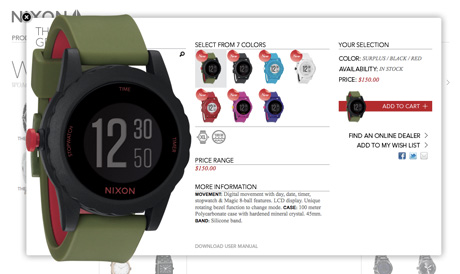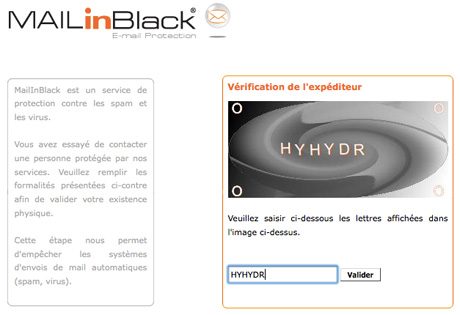Blog
Improve your work: leave early

A study was recently published in the Psychological Review about efficiency at work. Dr. K. Anders Ericcson studied the way musicians trained, and how long they trained, and compared their focus to their efficiency. The conclusion is that 80% of our outputs come from 20% of our inputs. And that working focused for 4 hours is more efficient than working unfocused for 8 hours. Otherwise said, this study advises us to be more focused for short periods in the day, and allow ourselves to rest: answer less phone calls, check emails less frequently and leave work early. Want to improve your work? Be ready to leave office early!
Enlarge images without border

Lightbox is a great tool to enlarge pictures on a web page, and offers multiple possibilities. Recenlty, I have seen this alternative on Nixon watches website: the enlargement of the product is displayed in a div with no border and no background. The result is interesting and the design simple. I don’t know whether or not it is Lightbox, but it looks cool!
Kyo: a new touch-free screen terminal

The 9th World Congress on Railway Research, which took place in Lille this May, was the opportunity to discover a new touch screen terminal. Well, as a matter of fact, Kyo does not involve any touch screen: the user can purchase a train ticket using only his gesture, and without any contact on the terminal. This idea was presented among other innovative processes for selling terminals, but could lead to new navigation methods in the next years. To be followed.
Intrusive cross selling

Cross selling is often the key to a performing e-commerce website. If the user wants to buy a dress, he could be in the mood for buying an accessory or another dress, for a competitive price? And while he’s in the checkout process, it can be a good idea to suggest additional and relevant articles. Cross selling is most of the times suggested in the products pages and in the shopping cart, and sometimes even during the checkout. In this example, the user purchasing a plane ticket has to decline twice the Insurance suggestion: once in a page displayed during the checkout, and once more (after clicking on Cancel) on a pop-up. A little too much, don’t you think?
FAQ vs. Contact us: a good example

As a user, it is hard to resist calling the company when you have a specific question. Why bother reading the whole FAQ looking for the answer, when it is so easy to call someone and directly ask for it? For the companies, answering quickly to any request is a must for the conversion, but this can be compromised by the number of requests. So the question is: how to make sure the phone contacts are really not answered by the FAQ, and try to reduce the number of personalized information requests? ING Direct is a very successful online bank, and has managed to find a good balance, in my point of view.
Too dissuasive anti spam (and anti conversion) process

Spams can be a hassle, and I agree sometimes you have to find a way to get rid of them. With current email systems and a few unsubscriptions, it’s become quite easy though, and I, for example, almost never see a spam: they go directly in my junk box. But according to how you use your email address, it can be more difficult. Last week, I tried to contact a company, and was surprised never to get an answer. Today, I finally realized it had been sent. Not only was the answer in my junk box, but it was an automatic reply. And this was not coming from the company itself, but from a website providing anti spam solutions. Basically, I had to click on a link, and then enter a captcha, before my first email was actually sent to the company. I was not a spammer, and could have become a client. Why make it so difficult to contact you? Except if you are overbooked for a few years, I wouldn’t advice going to so restrictive solutions. Let users contact you: this kind of process can definitely make a company loose customers and is of course quite bad for conversion.